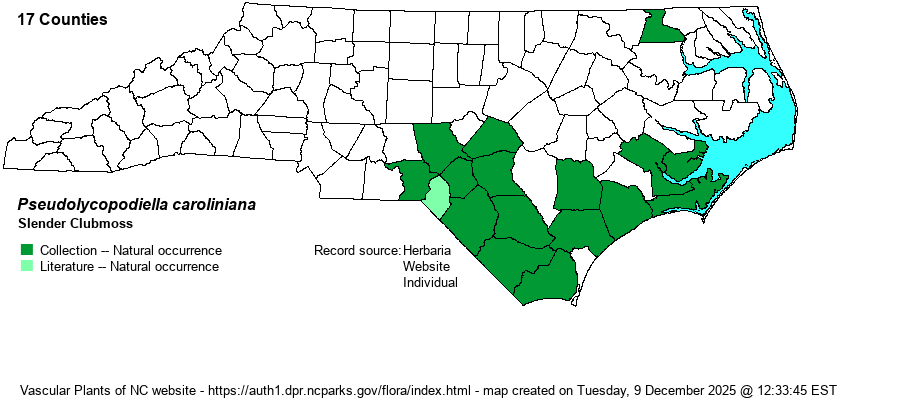| Author | (L.) Holub | |
| Distribution | Nearly throughout the southern 40-45% of the Coastal Plain, essentially in the Longleaf Pine zone. Also a record for the northern Coastal Plain (Hertford Co.). See notes under Taxonomic Comments regarding a newly recognized species split from caroliniana.
This is a Coastal Plain species, ranging from MA south to southern FL and west to eastern TX. Also occurs in Latin America, Africa, Asia. | |
| Abundance | Infrequent to fairly common in the Sandhills region and in the coastal counties from Craven and Carteret southward. Uncommon in the center of this range, and very rare in the northern Coastal Plain. The website editors recommend a State Rank of S3S4, as it is not really a scarce species. | |
| Habitat | The habitats of this species are very similar to those of the three Coastal Plain Lycopodiella species -- moist to wet acidic sandy places, almost always in association with Longleaf Pines. It grows in pine savannas, seepages, ditches near pine stands, streamhead pocosin edges, and other similar places. | |
| Phenology | Fruits from July to September. | |
| Identification | This is a familiar clubmoss of the Longleaf Pine wetlands, though certainly less numerous than L. alopecuroides and somewhat less numerous as L. appressa, though not nearly as widespread in the state. It is similar to members of that genus, with a prostrate sterile stem growing to about 4 inches long, often branched along the ground. These stems have a flattened aspect, with the lateral leaves rather broad and ovate, as opposed to linear in those in the other genus. As the upper and lower leaves are small, the "two-ranked" look of these sterile stems is very obvious. The few fertile stems rise erectly to about 6-8 inches tall, with a strobilus atop each one, each one narrow and about 2-3 inches long. Also, in this species/genus, the leaves on the fertile stem are rather sparse, short, and whorled, and thus at some distance the stalk appears almost devoid of leaves. | |
| Taxonomic Comments | This species was formerly named as Lycopodium carolinianum, and later as Lycopodiella caroliniana. In a 2015 Master's Thesis at Miami Univ., Ohio, Cook distinguishes diploid caroliniana from tetraploid species 1. Taxon Editors have not seen this publication, but will follow Weakley (2020) in accepting the new species. Both occur in NC, but specific county distributions need to be worked out.
| |
| Other Common Name(s) | Carolina Bog Clubmoss, Slender Bog Clubmoss, Carolina Clubmoss | |
| State Rank | S3 [S3S4] | |
| Global Rank | G4 | |
| State Status | | |
| US Status | | |
| USACE-agcp | OBL link |
| USACE-emp | FACW link |

